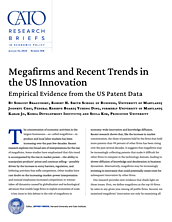A key issue in this debate is the role of megafirms in economy-wide innovation and knowledge diffusion. Recent research shows that, like the increase in market concentration, the share of patents held by the firms that hold more patents than 99 percent of other firms has been rising over the past several decades. It suggests that megafirms may be increasingly collecting patents that make it difficult for other firms to compete in the technology domain, leading to slower diffusion of knowledge and deceleration in business dynamism. Alternatively, megafirms may be increasingly investing in innovation that could potentially create room for subsequent innovation by other firms.
Our research provides new evidence that sheds light on these issues. First, we define megafirms as the top 50 firms by sales in any given year among all public firms. Second, we examined megafirms’ innovation not only by examining all patents but also by focusing on novel patents—patents that introduce new combinations of technological components that had never been utilized together before. Novel patents have been the subject of burgeoning research in recent years; this is motivated in part by the notion that many patents may be filed for purely strategic reasons and never applied to produce a commercial product. Novel patents represent economic experimentation and, if successful, may create pathways for new technological trajectories generating new products or adding new qualities to existing products.
Our research documents several new facts. First, the share of megafirms in novel patent applications had been declining for almost two decades, from 1980 to 2000, but there has been a turnaround since the early to mid-2000s. By the mid-2010s, the share of megafirms in novel patent applications was the highest since 1980. Furthermore, our work shows that megafirms are more likely to apply for novel patents, even after accounting for various firm characteristics, including size, industry, and the total number of patents held. Moreover, firms that became megafirms produced more novel patents than they did before they were megafirms. This suggests that gaining market leadership is associated with greater production of new technology combinations. Novel patents are also generally associated with better firm performance. Additionally, our research documents an increase in the overall number and share of novel patents in total patent applications in the United States since the mid-2000s, which reversed almost two decades of a declining trend.
Second, we tracked the number of follow-on patents— patents that use the same new technology combination as one first introduced by a novel patent—to measure the degree of success of a new combination. Our research finds that megafirms generate a disproportionately large number of hits—new technology combinations that lead to the largest numbers of follow-on patents—especially in recent years. Our work also examines the opposite side of the spectrum, not-yet-public startups backed by venture capital (VC) funding, and finds that these firms also play a disproportionately large role in generating novel patents, especially hit novel patents. Thus, most successful novel patents appear to be produced by two contrasting groups: megafirms and relatively small startups. Relatedly, among megafirms, an outsized role in generating hit novel patents in recent years belongs to those firms that became megafirms more recently (some of which were VC-backed startups themselves in the 1990s).
Third, our research discovers big changes in the technological content of new combinations that have been driving the recent resurgence in novel patents, compared with that of new combinations that underpinned novel patents in previous decades. Most novel patents in the 1990s involved new combinations of information and communications technology (ICT) components. Since the mid-2000s, however, most novel patents involve combining ICT with non-ICT components for the first time. Moreover, these new combinations are generated not only by firms whose primary industry is ICT-related but also by firms operating in non-ICT-related industries.
Finally, our research finds that compared with other firms, megafirms have smaller shares of follow-on patents assigned to the firm that generated the novel patent. This suggests that megafirms contribute to knowledge diffusion beyond their boundaries by engaging in technological experiments and generating impactful new combinations.
Our findings have important policy implications. If it is true that dominant megafirms are stifling innovation and slowing knowledge diffusion, there may be scope for regulatory intervention. If, however, those firms are the key actors conducting experiments and generating new technological trajectories, then such an approach may backfire.
Note:
This research brief is based on Serguey Braguinsky et al., “Mega Firms and Recent Trends in the US Innovation: Empirical Evidence from the US Patent Data,” National Bureau of Economic Research Working Paper no. 31460, August 2023.

